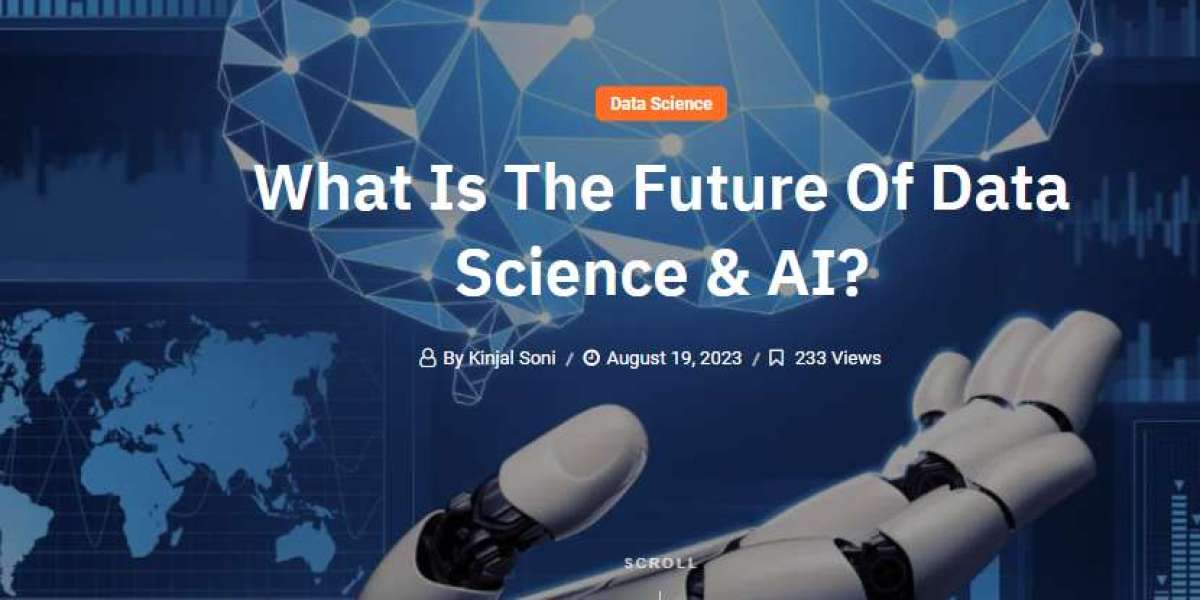Discover the potential of data science and AI development services and their impact on modern businesses through automation, data-driven decision-making, etc.
As we stand on the precipice of an ever-evolving technological landscape, the futures of data science and artificial intelligence (AI) intertwine with promises of unprecedented innovation.
These two fields are poised to shape our world in ways previously unimaginable, creating a synergy that extends the boundaries of human potential. From personalized experiences to autonomous decision-making, ethical considerations to interdisciplinary collaboration, the convergence of data science and AI holds the key to unlocking a future where human ingenuity and machine intelligence harmonize for the greater good. Let’s under this in detail further in the blog.
What is Data Science?
Data could be a valuable asset for businesses, but only if it is used effectively. Data Science is the study of data, its significance, its source, and transformations to get important insights.
Modern organizations rely on massive volumes of data, yet conventional Business Intelligence tools struggle to cope with such a flood of information. Unstructured Data is no longer a problem for the modern tools of Data Science. It can analyze information from a wide variety of media and marketing forms, text files, instrumental values, financial logs, and sensors.
A Relationship Analysis of Artificial Intelligence in Data Science
There is a vast ecosystem of tools and systems that may be used for the study of AI and data.
Perception > Planning > Action > Feedback of Perception
This pattern, or loop, is used in many ways by the field of data science to address a wide range of issues. In the first stage, called Perception, for instance, data scientists look for patterns in the information available to them. The next stage, planning, entails a similar split into two parts:
- Exploring any options
- Identifying the optimal option from among possible ones
Data science provides a framework for connecting the aforementioned factors, which in turn aids organizations in making progress.
Role of AI in the Field of Data Science
When it comes to expanding Data Science’s potential, artificial intelligence solutions are crucial. The following explanation elucidates how artificial intelligence contributes to Data Science:
Data science and Artificial Intelligence have been combined to create a Supervised form of Machine Learning, in which only a certain amount of available data is used to make predictions. Regression and Classification are two examples of Machine Learning algorithms used for Predictive Analysis.
Data Science and AI are sometimes used interchangeably because of their similar functions, although AI is only a technology utilized in Data Science. As Data Science focuses only on predictive analysis and employs Machine Learning methods for this purpose, it is just a partial representation of AI.
AI development services may provide a wide range of sophisticated analytical methods, not simply Machine Learning.
The Potential Impact of Data Science on Modern Businesses
Although humans will inevitably make mistakes in business due to our inherent fallibility, these blunders may be minimized via the employment of AI development services.
Many internal and external company operations may benefit from the use of data science services. In addition, businesses may benefit from data science services by developing sound data strategies and using cutting-edge ML and AI methods to mine data for previously undiscovered insights and possibilities.
Impact of Artificial Intelligence on Your Business
Artificial intelligence (AI) has rapidly advanced in recent years, becoming increasingly sophisticated, pervasive, and capable of carrying out useful activities. Thousands of companies now use AI development services for process, insight, and engagement in industries as diverse as manufacturing, retail, banking, and healthcare.
1. Process Applications
Simple operations like data-gathering, processing, and verifying are all examples of process applications. Automation made possible by AI can do repetitive activities in a fraction of the time it would take a person, allowing workers to devote their time and energy to more strategic endeavors. The following are examples of typical process uses:
- Schedule optimization
By using a Computer-Aided Facilities Management (CAFM) system, businesses may optimize appointment scheduling, delivery times, and staff schedules.
- Facilitating instant judgment
The necessary data may be retrieved in fractions of a second, making it easier for customer service and administrative staff to access complete inventory stock, upcoming schedules, complete client histories, staff data, and even projected weather delays on demand.
- Customized report delivery
With the help of AI development services, any task can be intelligently automated. Reporting doesn’t have to be a continual manual process; artificial intelligence solutions may help with that, too.
Reports may be automatically customized for each recipient depending on when they are generated, who is receiving them, what metrics are most important, and whether or not the data they include is considered private. Cloud-based AIs are so powerful that they can process huge reports in minutes rather than hours.
2. Insight-related Applications
The main difference between a process app and an insight app is that the latter is meant to recognize and learn from patterns. Here natural language processing (NLP) and optical character recognition (OCR) are used to evaluate human written and spoken text, while computer vision is utilized to handle visual media such as photographs and videos for improved information classification.
Data may also be used by insight apps to make predictions, giving consumers a sense of what the future could hold. The capabilities of insight apps include:
- Documentation analysis
A specified element, from an individual to a whole community, may be better understood by analyzing both private and public data. Reviews of social media profiles might reveal buying and media habits. Better diagnoses are possible via the use of data mining applied to medical records and physicians’ notes.
- Content customization
By using artificial intelligence solutions businesses may better serve customers by creating relevant, personalized content after they have a better grasp of their tastes and habits. Media suggestions can be made based on what people are interested in. The most probable buyers may be sought out and offered incentives and specials. Insurers and financiers may tailor their risk-assessment algorithms to their clients’ needs.
- Detecting and estimating
Now that NLP has matured, it may be used in any field. The latest developments in NLP software are capable of detecting sarcasm, fraud, false news, and even emotion. Predicting the likelihood of fraud or other components of interest enables firms to take preventative measures before any actual damage is done.
3. Engagement Applications
An engagement application uses processes and data to interact directly with people. These AI apps can interact with users in ways that are both natural and easy to understand and employ. A few of the many uses for “engagement” apps are:
- Facilitating diagnosis
Chatbots in the healthcare industry may do a lot of useful things, like asking patients about their symptoms and medical history, answering their questions, and keeping them up to speed on their appointments and treatment plans. Both physicians and patients in outlying areas may benefit from this development.
- Chatbots
These chatbots are the initial point of contact for many businesses with new clients. Whether embedded in a website or functioning as a separate app, chatbots may provide basic informational responses to inquiries, link users to relevant resources, and gather data that can be sent to a human agent.
- Tools for workers
Companies may facilitate worker productivity by creating internal information resources for answering IT-related queries, providing HR assistance, and outlining standard operating practices. The onboarding process is another area where managers and supervisors may save time with the use of chatbots.
Conclusion
Data science and artificial intelligence are altering the jobs landscape, presenting a bright future for prospective professionals. The enormous rise of data, the changing labor market, and the broad application of data science and artificial intelligence approaches across sectors all contribute to an increase in demand for trained people.
Data science and AI enable innovation, growth, and remote work by extracting useful insights from data, creating intelligent systems, and solving challenging business challenges.
For more info: https://sigmasolve.com/what-is-the-future-of-data-science-ai/



